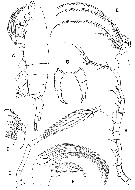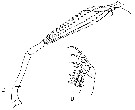|
|
 |
|
Calanoida ( Ordre ) |
|
|
|
Diaptomoidea ( Superfamille ) |
|
|
| |
| | | |
| Sulcanidae Nicholls, 1945 ( Diaptomoidea ) | | Ref.: | Nicholls, 1945 c (p.513); Andronov, 1974 a (p.1005); Bowman & Abele, 1982 (p.9); Razouls, 1982 (p.627); Dussart & Defaye, 1983 (p.45); Huys & Boxshall, 1991 (p.406, 419); Barthélémy, 1999 a (p.28); Bradford-Grieve, 1999 b (p.211, Def.); Ohtsuka & Huys, 2001 (p.461); Boxshall & Halsey, 2004 (p.12; 49; 202: Def.); Blanco-Bercial & al., 2011 (p.103, Table 1, Fig.2, 3, 4, molecular biology, phylogeny); Laakmann & al., 2019 (p.330, fig. 2, 3, phylogenetic relationships)
Bradford-Grieve J.M., (2002 onwards). Key to calanoid copepod families. Version 1 : 2 oct 2002. http://www.crustacea.net/crustace/calanoida/index.htm  | | Rem.: | Brodsky, 1980 (pers. comm.) place cette famille après celle des Tortanidae.
1 G.: Sulcanus. |  tly elongated segmlents; the long setae |
 Issued from : G.A. Boxshall & S.H. Halsey in An Introduction to Copepod Diversity. The Ray Society, 2004, No 166, Part. I. [p.202]. Armature formula of swimming legs P1 to P4. Outer spines on all exopodal segments of legs 2 to 4 fused to segment; outer spines on 3rd exopodal segment of leg 1 distinct at base. Nota : P5 female comprising broad transverse plate formed by fusion of coxae and intercoxal sclerite. Each leg 3-segmented and uniramous ; comprising unarmed basis and 2-segmented exopod. 1st exopodal segment unarmed, 2nd tapering distally, slightly curved and claw-like ; outer margin strongly serrated on right side only. - Male P5 asymmetrical ; intercoxal sclerite and protopodal segments fused to form robust trnsverse plate ; right leg with muscular basal pedestal carrying curved, claw-like unsegmented exopod distally and 3 processes on inner margin, one of which probably representing endopod. Left leg uniramous, lobate, indistinctly subdivided into robust, muscular proximal part and rounded distal part armed with 1 to 3 setae. - Eggs released into water. Remark: Apparently there is a mistake in the formula on P1: the seta is on inner of coxa and not on inner of basis. |
 Issued from : J.M. Bradford-Grieve in NIWA Biodiversity Memoir, 111, 1999. [p.211]. Setal formula of swimming legs P1 to P4. - P5 uniramous, 3-segmented, and slightly asymmetrical in female. - Left P5 male uniramous and right leg biramous, with both strongly modified. Note on the distal inner part of basipod 1 (= coxa) the presence of one seta. | | | | | (1) Sulcanus Nicholls, 1945 | |
| | Ref.: | Nicholls, 1945 c (p.511); Razouls, 1982 (p.627); 1993 (p.507); Mauchline, 1998 (p.66); Bradford-Grieve, 1999 b (p.211, Def., Rem.) | | Rem.: | Total: 1 sp.
Genre proche des Parapontellidae. | | Remarques sur les dimensions et le sex-ratio: | | The mean female size is 1.5 mm (1.6-1.4 mm), and the mean male size is 1.55 mm (1.5-1.6 mm) |  Issued from : G.A. Boxshall & S.H. Halsey in The Ray Society, , 2004, N° 166.[p.203, Fig.51, C, D]. Sulcanus conflictus Female: C, A2; D, Mx1. Nota: A2 uniramous; with no trace of exopod; 3-segmented, proximal segment (coxa) very short, unarmed; middle segment (allobasis) extremely elongated and armed with single seta (basal in origin) near midlength, distal segment (fused 2nd and 3rd endopodal segment) slender, not bilobed, with 6 long setae apically. Mx1 reduced, 2-segmented; 1st segment armed with 11 elements along inner margin (possibly representing praecoxal arthrite); 2nd segment small, bearing 3 elements distally. | | | | | |
|
|
 Toute utilisation de ce site pour une publication sera mentionnée avec la référence suivante : Toute utilisation de ce site pour une publication sera mentionnée avec la référence suivante :
Razouls C., Desreumaux N., Kouwenberg J. et de Bovée F., 2005-2025. - Biodiversité des Copépodes planctoniques marins (morphologie, répartition géographique et données biologiques). Sorbonne Université, CNRS. Disponible sur http://copepodes.obs-banyuls.fr [Accédé le 19 novembre 2025] © copyright 2005-2025 Sorbonne Université, CNRS
|
|
 |
 |





